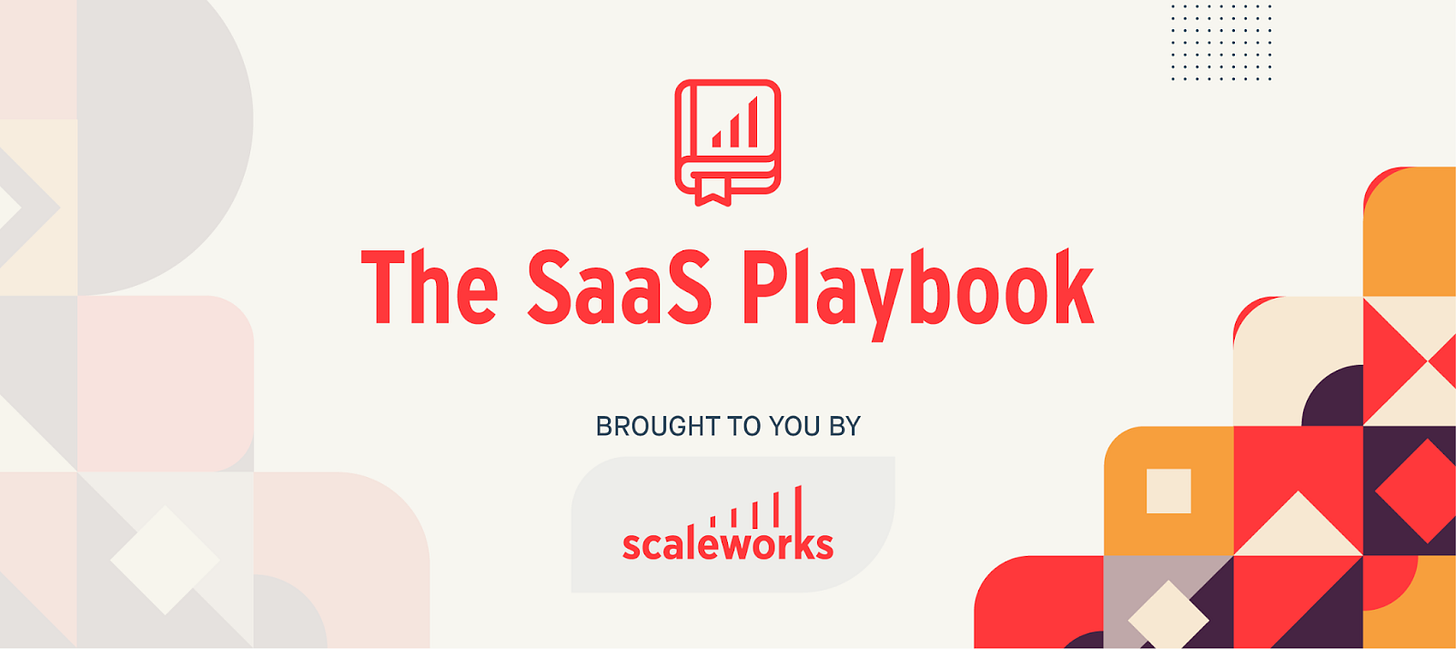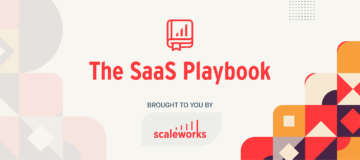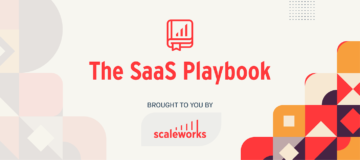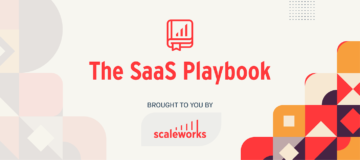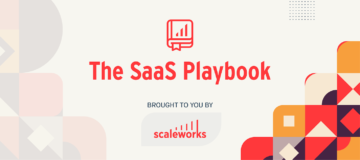Before diving into this week’s playbook, I want to introduce Scaleworks (who pays the Playbook’s bills) to some of our newer readers. We’re a group that acquires and invests in B2B software usually doing somewhere between $3m–$10m in ARR. When people hear the word acquire they often think of classic Private Equity, a.k.a. loads of debt, optimization for cashflow, and as a result, low growth. That’s not really our model. We have a growth first mindset – but within reason – and like to scale in a capital efficient way that doesn’t have the repercussions of VC “all or nothing” growth targets. For our long time readers, I’m sure you’ve gathered that from previous playbooks.
If you or someone you know is considering selling, taking investment, or even looking for a bit of debt (we do offer debt for growth) we might be able to help out. Just reply to this thread and we can get acquainted. We may or may not be a perfect fit, but we’re always up for meeting SaaS founders and extending our network where helpful.
Alright, back to our regular programming. Happy Friday, and enjoy this week’s playbook!
👨🚀 This Tuesday, payments company Fast announced that they ran out of cash and are shutting down after raising $125m just one year ago. That might be the fastest (pun intended) we have ever heard of a company burning through $100m+. So how did they get there? A few ex-employees, unfortunately known as Fastronauts, told NPR that CEO Domm Holland was pouring money into partnerships with sports teams and other high profile organizations aimed at “creating buzz”. Focus on these glamorous deals while neglecting to get any real business in the door (2021 revenues were a reported $600k) surely had a major part to play, but burning $125m is hard to do regardless of a lack of revenues to offset burn. We would expect more details on the specifics soon.
⏪ The last couple of years were great for startups raising capital, as there was more money than ever to deploy and more competition amongst those deploying it, which has led to bigger checks and higher valuations. Tau Ventures saw a roughly 40% increase in valuations (as a function of amount raised) over the period, but in Q1 2022 started to see a reversal of that uptick. The data below (via Carta) shows that the amount being raised per round is certainly down – almost 30% for Series A rounds. While there are many factors spurring the change (the reallocation of software funds to industries recovering from COVID, the fed’s hike in interest rates, and the Ukraine crisis to name a few), one thing is for sure – founders and CEOs will need to be more cash conscious as the cost of capital increases.
🔔 If you have the task of creating or even just rebuilding your company’s financial model, there’s little reason for you to start from scratch. There are endless amounts of great resources around SaaS modeling which can serve as a starting point. Stéphan Nasser put together a review of his top 12 choices, which compares each model based on the strength of their financial statements, analysis capabilities, revenue modeling, costs modeling, and bells and whistles (extra features). We personally are big fans of Taylor Davidson’s SaaS Financial Model and SaaS: Enterprise, SME & Users by Alexander Jarvis (both covered in the article).
🤝 We’re big believers in the idea that everyone should work in customer service at least once in their life. Typically, your customers aren’t reaching out to provide glowing reviews of your product. They reach out to support when there’s an issue. Being down in the trenches with your support team is essential for so many reasons; but most importantly it provides insight into how your product is working outside of controlled environments. From a strategic standpoint, your marketing and C-suite can garner more authentic feedback to answer questions like, “are we highlighting the right value proposition?” For the dev team, it can highlight if you are building the right set of features to meet your markets’ needs, or are you overwhelming them with useless bells and whistles.
- SEO Powered Content & PR Distribution. Get Amplified Today.
- Platoblockchain. Web3 Metaverse Intelligence. Knowledge Amplified. Access Here.
- Source: https://thesaasplaybook.substack.com/p/-are-saas-valuations-correcting-how
- 10
- 2022
- 9
- a
- Able
- acquainted
- acquire
- Acquires
- After
- Alexander
- always
- amongst
- amount
- amounts
- analysis
- and
- announced
- answer
- around
- article
- Authentic
- B2B
- back
- based
- being
- believers
- bells
- below
- BEST
- between
- Big
- bigger
- Bills
- Bit
- Building
- burn
- business
- button
- C-suite
- Can Get
- capabilities
- capital
- Cash
- ceo
- CEOs
- certainly
- change
- Checks
- choices
- classic
- COM
- company
- Company’s
- competition
- conscious
- considering
- controlled
- Cost
- Costs
- Couple
- covered
- Covid
- Creating
- crisis
- customer
- Customer Service
- Customers
- data
- Deals
- Debt
- deploy
- deploying
- details
- Dev
- DID
- Doesn’t
- doing
- Door
- down
- each
- efficient
- Endless
- enjoy
- Enterprise
- equity
- essential
- Ether (ETH)
- Even
- EVER
- everyone
- expect
- extending
- extra
- factors
- fans
- FAST
- fastest
- Features
- feedback
- few
- financial
- First
- fit
- Focus
- For Startups
- founders
- Friday
- from
- function
- funds
- get
- good
- great
- Group
- Growth
- happy
- Hard
- heard
- help
- helpful
- High
- higher
- Highlight
- highlighting
- Hike
- Holland
- How
- HTTPS
- idea
- in
- Increase
- Increases
- industries
- insight
- interest
- Interest Rates
- introduce
- investment
- Invests
- issue
- IT
- just one
- Know
- known
- Lack
- Last
- Led
- Life
- little
- loads
- Long
- long time
- looking
- Low
- major
- many
- Marketing
- medium
- Meet
- meeting
- might
- Mindset
- model
- modeling
- money
- more
- most
- name
- Need
- needs
- network
- offer
- offset
- ONE
- optimization
- organizations
- Other
- outside
- part
- partnerships
- payments
- pays
- People
- perfect
- period
- Personally
- plato
- Plato Data Intelligence
- PlatoData
- Play
- Point
- previous
- primary
- private
- Private Equity
- Product
- Profile
- Programming
- proposition
- provide
- provides
- put
- Q1
- Questions
- raised
- raising
- raising capital
- Rates
- reach
- readers
- real
- reason
- reasons
- recovering
- Regardless
- regular
- repercussions
- reply
- Reported
- Resources
- result
- revenue
- revenues
- Reversal
- review
- Reviews
- roughly
- round
- rounds
- SaaS
- Scale
- Selling
- Series
- Series A
- serve
- service
- set
- Shoot
- should
- Shows
- SME
- So
- Software
- some
- Someone
- somewhere
- Soon
- Sports
- Sports Teams
- start
- started
- Starting
- Startups
- statements
- Strategic
- strength
- support
- surely
- taking
- targets
- Task
- team
- teams
- templates
- The
- their
- thing
- Through
- time
- to
- together
- top
- true
- Tuesday
- typically
- Ukraine
- us
- users
- usually
- Valuations
- value
- VC
- Ventures
- via
- which
- while
- WHO
- will
- within
- Word
- Work
- working
- would
- year
- years
- Your
- zephyrnet

